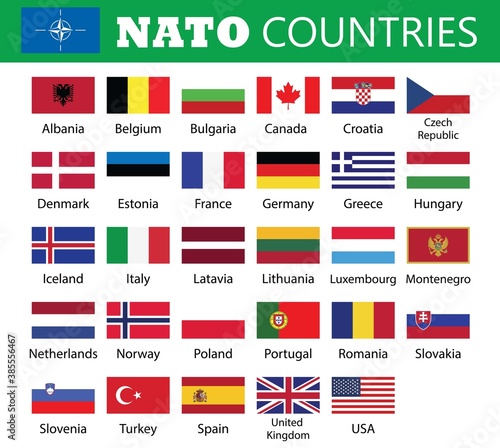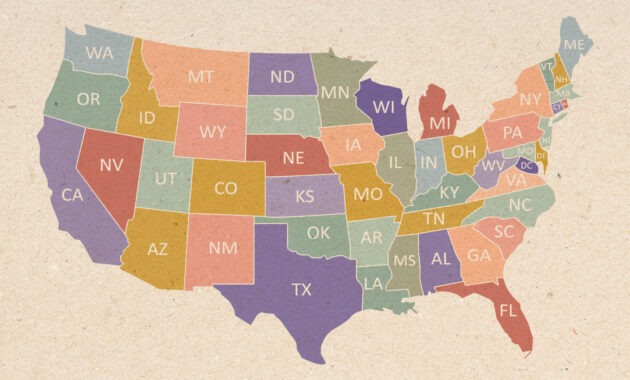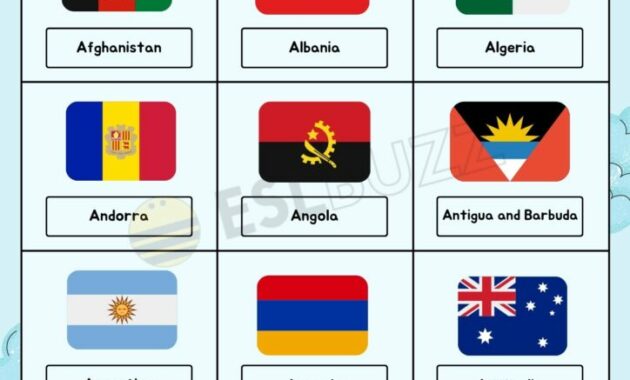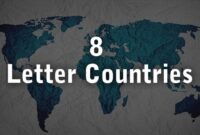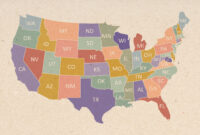The North Atlantic Treaty Organization (NATO) stands as a testament to international cooperation and collective defense in the face of evolving global challenges. Born in the aftermath of World War II, NATO emerged from a desire to foster stability and security in Europe and North America. Its core principle, enshrined in Article 5 of the North Atlantic Treaty, is that an attack on one member is an attack on all, binding allies together in a commitment to mutual defense. This principle has served as a cornerstone of transatlantic security for over seven decades, deterring aggression and safeguarding peace.
NATO Member States Flags

The strength of NATO lies not only in its military capabilities but also in the shared values and democratic principles that unite its members. From its initial 12 founding members, NATO has expanded over the years to include countries from across Europe and North America, reflecting a growing commitment to transatlantic security and shared values. Each member state contributes its unique strengths and perspectives to the alliance, enriching its collective decision-making and operational effectiveness. The flags displayed represent a diverse tapestry of nations, all bound together by a common goal: to safeguard peace and security in the Euro-Atlantic area. The interweaving of these national identities within the framework of NATO underscores the alliance’s ability to bridge cultural and historical differences in pursuit of a shared vision for a more stable and secure world.
The composition of NATO’s membership has evolved significantly since its inception, reflecting geopolitical shifts and the changing security landscape. The fall of the Berlin Wall and the dissolution of the Soviet Union led to a wave of new members from Central and Eastern Europe, demonstrating NATO’s commitment to extending security and stability to countries emerging from decades of communist rule. These expansions not only strengthened NATO’s defense capabilities but also reinforced its commitment to promoting democracy and the rule of law in the region. The inclusion of countries with diverse historical experiences and perspectives has enhanced NATO’s ability to address a wider range of security challenges, from traditional military threats to cyber warfare and terrorism. This continuous adaptation and evolution have been crucial to NATO’s enduring relevance and effectiveness in the 21st century.
Beyond its core mission of collective defense, NATO plays a vital role in promoting international cooperation and crisis management. Through partnerships with countries around the world, NATO works to enhance security cooperation, share expertise, and build capacity in areas such as counter-terrorism, cybersecurity, and maritime security. These partnerships are essential for addressing transnational threats that transcend national borders and require coordinated international efforts. NATO also conducts crisis management operations, often in response to requests from international organizations such as the United Nations. These operations can range from humanitarian assistance to peacekeeping missions, demonstrating NATO’s commitment to using its capabilities to promote stability and alleviate suffering in conflict-affected regions. The alliance’s ability to adapt its role and engage in a diverse range of activities has cemented its position as a key player in international security.
The flags themselves are potent symbols of national identity, each representing a unique history, culture, and set of values. Their collective display within the context of NATO symbolizes a shared commitment to defending those values and upholding the principles of democracy, individual liberty, and the rule of law. The arrangement of these flags often reflects the alphabetical order of the member states’ names, a subtle yet significant reminder of the equality and mutual respect that underpin the alliance’s decision-making processes. The visual representation of these national flags serves as a powerful reminder of the human dimension of NATO’s mission, reminding us that the alliance is ultimately about protecting the citizens and values of its member states. The presence of these flags at NATO headquarters and at allied military installations around the world serves as a constant reminder of the alliance’s unwavering commitment to collective defense and the enduring bonds that unite its members.
NATO Member Countries Flags
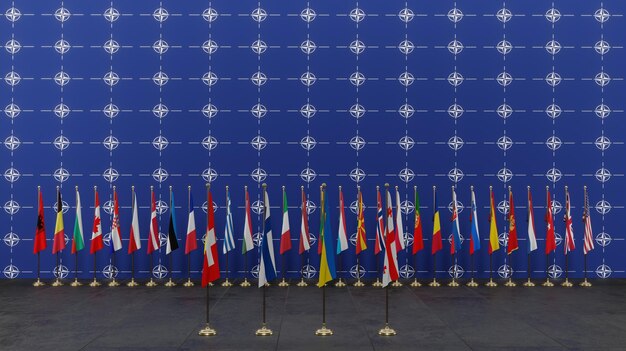
NATO summits are pivotal events that bring together heads of state and government from member countries to discuss pressing security challenges and set the alliance’s strategic direction. These summits provide a forum for leaders to reaffirm their commitment to collective defense, address emerging threats, and strengthen cooperation on a wide range of issues. The decisions made at NATO summits shape the alliance’s policies, priorities, and resource allocation, ensuring that it remains prepared to meet the evolving security challenges of the 21st century. The presence of the flags of member states at these summits serves as a powerful reminder of the shared responsibility and commitment to collective security that binds the alliance together. The symbolism of these gatherings extends beyond the formal proceedings, fostering a sense of camaraderie and shared purpose among the leaders and officials who participate. The discussions and interactions that take place at NATO summits play a crucial role in maintaining the strength and unity of the alliance.
The flags of NATO member countries represent not only their national sovereignty but also their collective commitment to upholding international law and the rules-based international order. By working together within the framework of NATO, member states are able to amplify their individual strengths and address security challenges that no single nation can effectively address alone. This collaborative approach is essential for maintaining stability and deterring aggression in an increasingly complex and interconnected world. The alliance’s commitment to the rules-based international order is reflected in its adherence to international law, its support for multilateral institutions, and its efforts to promote democracy and good governance around the world. By upholding these principles, NATO contributes to a more just and peaceful world, where the rights and freedoms of all nations are respected.
Looking ahead, NATO faces a number of significant challenges, including rising geopolitical tensions, the proliferation of advanced weapons technologies, and the growing threat of cyberattacks and disinformation campaigns. To address these challenges, NATO must continue to adapt its capabilities, strengthen its partnerships, and invest in innovative technologies. The alliance must also maintain its unity and resolve in the face of external pressures and internal divisions. The flags of NATO member countries serve as a constant reminder of the shared values and common interests that bind the alliance together, providing a foundation for continued cooperation and collective action. By remaining vigilant and adaptable, NATO can continue to play a vital role in safeguarding peace and security in the Euro-Atlantic area for generations to come.
In conclusion, the flags of NATO member states are more than just symbols of national identity; they represent a shared commitment to collective defense, democratic values, and the rules-based international order. They embody the spirit of cooperation and solidarity that has defined NATO for over seven decades and continues to guide its mission in the 21st century. As the alliance navigates an increasingly complex and challenging security landscape, the flags of its member states serve as a powerful reminder of the enduring bonds that unite them and the unwavering commitment to safeguarding peace and security for all.
If you are searching about Premium Vector | NATO member states flags Flat national flags of you’ve came to the right web. We have 5 Pics about Premium Vector | NATO member states flags Flat national flags of like NATO Member Countries Member Countries Flags Drawing By , 45% OFF, NATO Member Countries Flags.NATO Member Countries Flags drawing by and also Premium Photo | NATO Member countries flags Flags of NATO members NATO. Here you go:
Premium Vector | NATO Member States Flags Flat National Flags Of

www.freepik.com
NATO Member Countries Member Countries Flags Drawing By , 45% OFF

www.gbu-presnenskij.ru
Premium Photo | NATO Member Countries Flags Flags Of NATO Members NATO

www.freepik.com
NATO Member Countries Flags.NATO Member Countries Flags Drawing By

stock.adobe.com
Premium Photo | Nato Member Countries Flags Flags Of Nato Members Nato

www.freepik.com
Premium photo. Nato member countries member countries flags drawing by , 45% off. Nato member countries flags.nato member countries flags drawing by

